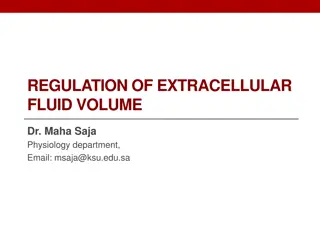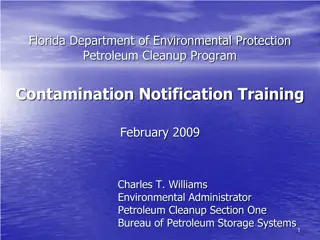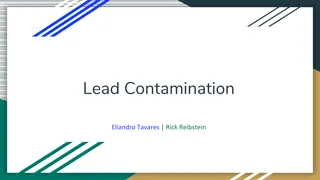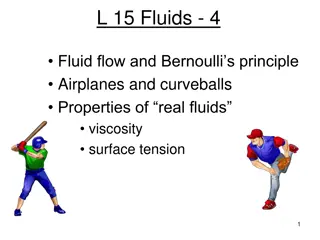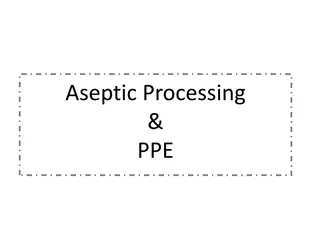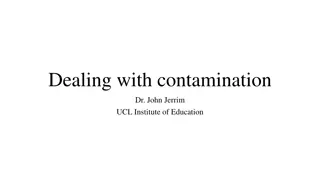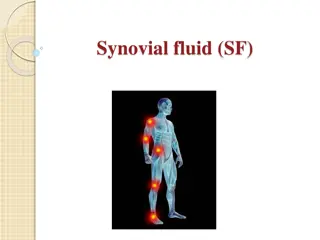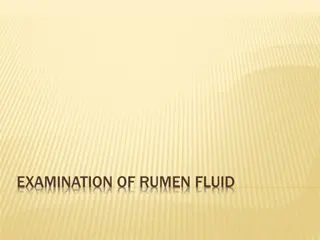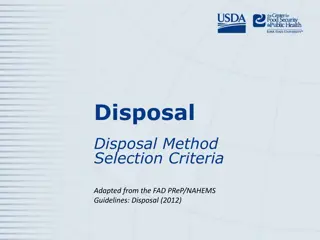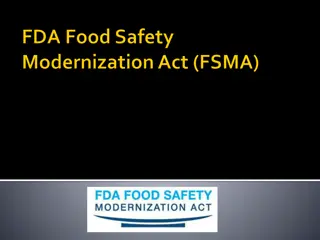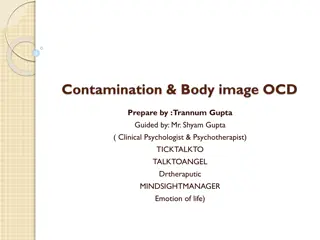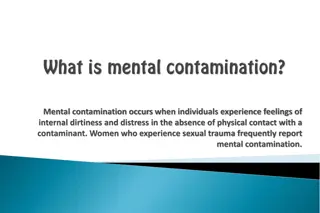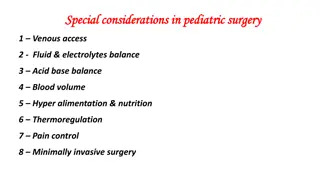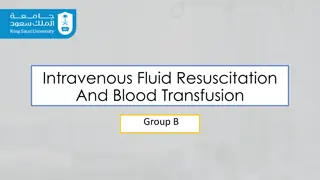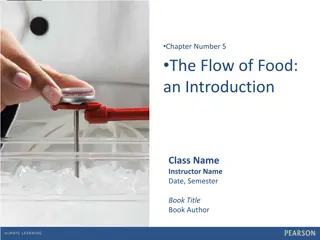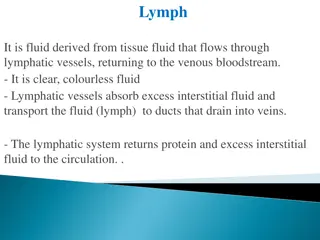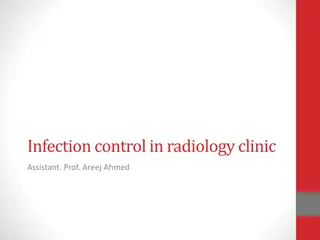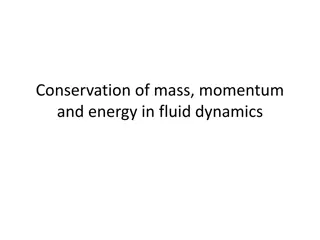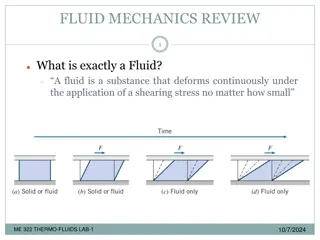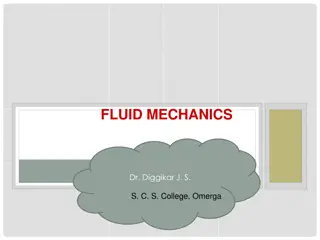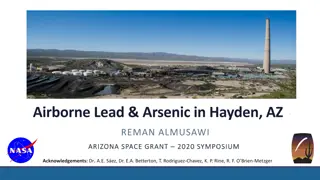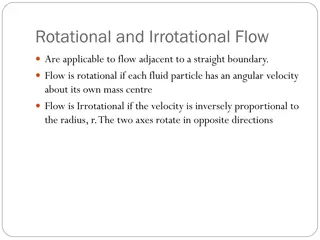Fluid Management in ICU: Understanding Body Fluid Compartments and Types of Fluids
Fluid management in the ICU is crucial for patient care. This includes understanding the distribution of body fluid compartments, such as intravascular, interstitial, and intracellular fluids. Different types of fluids like crystalloids and colloids play essential roles in treatment. Crystalloids ar
3 views • 26 slides
Understanding Fluid Pressure in Oil Field Hydraulics
Explore the fundamentals of fluid pressure including pressure basics, unit conversion, fluid weight constants, true vertical depth, and hydrostatic pressure in the context of oil and gas technology programs. Learn how to calculate pressure gradients, understand the impact of fluid density on pressur
1 views • 40 slides
Understanding Fluid Therapy in Veterinary Medicine
In the nineteenth century, fluid therapy was limited to severely ill patients, but now both veterinary and human medicine utilize intravenous fluid therapy extensively. Dehydration can have serious consequences, and isotonic replacement fluids are essential based on estimated dehydration, maintenanc
1 views • 20 slides
Overview of Fluid Mechanics: Branches, Flow Types, and Equations
Fluid mechanics is subdivided into three branches: Fluid Static, Kinematics, and Hydrodynamics. The study of fluid flow includes different types such as uniform, non-uniform, steady, and unsteady flow. The motion of fluid particles obeys Newton's laws, and the conservation of mass and energy plays a
1 views • 4 slides
Understanding Food Microbiology: Sources of Contamination
Humans have broader nutritional requirements than most microorganisms. The human diet includes a wide variety of substances, making our food excellent media for microbial growth. Natural contamination of food by various microorganisms, including pathogens, is common. Food consumed by humans and anim
0 views • 51 slides
Understanding Fluid Machines: Specific Work and Energy Transfer
In Chapter 3 of "Specific Work of Fluid Machines" by Eng. Mesfin B., the focus is on energy transfer and determination of specific work. The chapter covers topics such as energy loss, total pressure, the Bernoulli equation, and more. Learn how to calculate mechanical energy and power transferred by
4 views • 33 slides
Introduction to Fluid Logic Control Systems
Fluid logic control systems utilize devices that switch fluid, like air, between outlets, providing ON/OFF outputs swiftly based on control signals. This article explores moving-part logic devices, control functions, Boolean algebra applications in control technology, and advantages of fluid logic s
1 views • 22 slides
Regulation of Extracellular Fluid Volume in Renal Physiology
This lecture focuses on the mechanisms involved in the regulation of extracellular fluid volume, primarily highlighting the role of sensors, effectors, and the kidney in maintaining body fluid balance. It discusses the importance of regulating extracellular fluid volume and osmolarity for controllin
0 views • 25 slides
Understanding Non-Dimensional Numbers in Fluid Mechanics
Non-dimensional numbers play a crucial role in understanding fluid motion. This includes Reynolds Number for inertia and viscous forces, Froude Number for gravity effects, Cauchy Number for compressible flows, and Mach Number for elasticity forces. These numbers help in analyzing pipe friction, flow
1 views • 10 slides
Understanding Fluid and Electrolyte Management in Surgical Patients
This article delves into the intricacies of fluid and electrolyte management in surgical patients, covering topics such as total body water distribution, fluid compartments, electrolyte composition, body fluid changes, and disturbances in volume, concentration, and composition. It explores the fluid
0 views • 25 slides
Understanding Fluid Mixing in Chemical Reactions
The problems associated with fluid mixing during reactions are crucial for fast reactions in both homogeneous and heterogeneous systems. These issues involve the degree of segregation of the fluid and the timing of mixing. Concepts like RTD are intertwined with fluid mixing, affecting the behavior o
1 views • 46 slides
Understanding Fluid Flows in Fluid Mechanics
Fluid Mechanics is the study of fluids in motion or at rest, and their interactions with solids or other fluids. Fluid flows are classified based on various characteristics such as viscous versus inviscid regions, internal versus external flow, compressible versus incompressible flow, laminar versus
1 views • 16 slides
Marine Corps Expeditionary Fluid Analysis System (EFAS) Overview
The USMC Expeditionary Fluid Analysis System (EFAS) led by Mr. Anton Schager is a deployable, real-time fluid analysis system supporting Condition-Based Maintenance for Marine Corps ground equipment. It consists of two tiers - a ruggedized portable analyzer for tactical units and a benchtop analyzer
4 views • 12 slides
Safeguarding Your Kitchen: Preventing Cross-Contamination
Cross-contamination poses a risk of foodborne illnesses and can occur in multiple ways, such as using the same utensils for raw and cooked foods. Taking specific cleaning steps at home, like regularly cleaning dish cloths and sanitizing surfaces, is vital to preventing harmful bacteria from spreadin
0 views • 8 slides
Contamination Notification Training: Florida Department of Environmental Protection
This document outlines the Contamination Notification Training provided by the Florida Department of Environmental Protection in February 2009. It covers types of contamination notification, governing statutes, rules, and guidance, specific noticing requirements, and changes from prior guidance. The
0 views • 25 slides
Perioperative Fluid Therapy: Key Concepts and Considerations
Understanding perioperative fluid therapy is crucial for maintaining normovolemia, achieving hemodynamic stability, and preventing complications. Factors such as total body water variation, fluid resuscitation goals, desirable outcomes, and fluid and electrolyte regulation play a critical role in en
3 views • 56 slides
Addressing Lead Contamination: Advocating for Effective Legislation
Working towards effective lead contamination legislation involves setting clear goals, engaging with experts and legislators, expanding testing and awareness efforts, and ensuring existing laws are enforced. Key figures like Senators Chang-Diaz and Eldridge are involved, along with advocacy at event
3 views • 6 slides
Understanding Fluid Dynamics and Bernoulli's Principle in Real-world Applications
Explore the fascinating world of fluid dynamics with a focus on Bernoulli's principle through real-life examples like air flow in wind tunnels, airplane wings, and even tornado behavior. Discover how changes in fluid velocity affect pressure and how streamlines provide insights into fluid flow behav
1 views • 23 slides
Understanding Aseptic Processing and Contamination Control in Cleanroom Environments
Aseptic processing involves maintaining a sterile environment to prevent contamination in cleanroom settings. The presence of non-viable and viable particulate contamination, such as dust and live microorganisms, poses challenges. Sources of contamination include equipment, structures, surfaces, and
0 views • 29 slides
Understanding Contamination in Research Studies
Understand the concept of contamination in research studies, its impact on the effectiveness of Randomized Controlled Trials (RCTs), and different analysis methods to handle contamination, such as Intention-to-Treat (ITT) and Contamination-Adjusted Intention-to-Treat (CA-ITT) analyses. Learn how to
0 views • 40 slides
Understanding Synovial Fluid and Its Role in Joint Health
Synovial fluid, also known as joint fluid or synovia, is a plasma dialysate that lubricates joints and allows for smooth movement. It is produced by the synovium and contains important components like hyaluronic acid and lubricin. This fluid reduces friction, provides shock absorption, supplies nutr
0 views • 27 slides
Examination of Rumen Fluid and Methods of Collection
The examination of rumen fluid is crucial for diagnosing rumen diseases and for therapeutic purposes like transfaunation. Various physical and chemical characteristics are analyzed, including color, consistency, pH levels, and sedimentation activity. Abnormal findings indicate different health issue
0 views • 17 slides
Guidelines for Animal Disposal Methods
Environmental and biosecurity guidelines recommend various disposal methods such as composting, rendering, permitted landfill, unlined burial, fixed-facility incineration, and open-air burning. Each method has specific selection criteria and considerations to minimize risks to the environment and bi
0 views • 17 slides
Agricultural Water Safety Regulations Overview
The final Produce Rule and Preventive Controls Rule, effective since November 13, 2015, set criteria for microbial contamination in agricultural water. Generic E. coli levels are key indicators, affecting water uses in post-harvest and production. Criteria like Geometric Mean and Statistical Thresho
0 views • 43 slides
Understanding Contamination OCD: Symptoms, Obsessions, and Misconceptions
Contamination OCD is a subset of OCD characterized by severe fears of becoming contaminated by germs or getting sick. Individuals with this condition may exhibit compulsions such as avoidance, excessive washing, and health testing. It's crucial to differentiate between normal intrusive thoughts and
0 views • 21 slides
Understanding Mental Contamination: Causes and Effects
Mental contamination is a phenomenon where individuals experience feelings of internal dirtiness and distress without physical contact with a contaminant. It is common among women who have experienced sexual trauma. Symptoms include fear of imagined contaminants, ritualistic acts to neutralize them,
0 views • 7 slides
Pediatric Surgery: Special Considerations for Venous Access and Fluid Management
Pediatric surgery requires special attention to venous access and fluid management due to unique considerations in infants and children. Key aspects include methods for obtaining vascular access, monitoring fluid and electrolyte balance, and addressing specific fluid requirements based on age and we
0 views • 15 slides
Understanding Intravenous Fluid Resuscitation and Blood Transfusion in Clinical Practice
Intravenous fluid resuscitation and blood transfusion are crucial components of patient care, involving the direct administration of fluids and electrolytes to maintain proper fluid balance. When calculating the volume of fluid to be replaced, various factors must be considered, including maintenanc
0 views • 15 slides
Food Safety and Cross-Contamination Prevention Guidelines
Understanding the flow of food is crucial in preventing cross-contamination at various stages of food handling. This chapter delves into key terms, temperature-measuring devices, calibration methods, and guidelines to prevent cross-contamination. By implementing separate equipment, proper cleaning,
0 views • 23 slides
Best Practices for Contamination Control in Pharmaceutical Manufacturing
Implementing a robust Contamination Control Strategy (CCS) as part of the Pharmaceutical Quality System is crucial for ensuring product quality and safety. The strategy encompasses various elements like process risk management, preventative maintenance, and personnel training. Manufacturers must foc
0 views • 19 slides
Understanding Buoyancy and Archimedes' Principle
Buoyancy is the upward force experienced by a body when immersed in a fluid, counteracting gravity. This force is determined by Archimedes' principle, which states that the buoyant force is equal to the weight of the fluid displaced. For floating bodies, the weight of the body equals the buoyant for
0 views • 4 slides
Exploring Pesticide Monitoring and Contamination Studies in Maine
Mary Tomlinson's work with the Maine Board of Pesticides Control includes past studies on groundwater and surface water monitoring, ongoing monitoring initiatives, and future collaborative studies. The State Law mandates residue surveys to identify possible contamination sources and develop a pestic
1 views • 55 slides
Understanding the Lymphatic System: Functions and Importance
Lymph is a clear, colorless fluid that plays a crucial role in maintaining the body's fluid balance, immune response, and lipid absorption. The lymphatic system functions to return excess fluid and proteins to the bloodstream, aid in immunity through lymphocytes, absorb dietary lipids, and regulate
0 views • 13 slides
Radiographic Infection Control in Dental Clinics
In dental radiology clinics, infection control is crucial to prevent cross-contamination and disease transmission among patients and staff. Key steps include applying standard precautions, wearing personal protective equipment, disinfecting equipment, and preventing contamination of processing equip
0 views • 16 slides
Understanding Conservation Principles in Fluid Dynamics and Classical Mechanics
Conservation principles play a significant role in fluid dynamics and classical mechanics. In fluid dynamics, conservation of mass, momentum, and energy are crucial for understanding fluid behavior. Classical mechanics, on the other hand, relies on Newton's laws to describe motion and energy conserv
0 views • 46 slides
Understanding Fluid Mechanics Fundamentals
Fluid mechanics is the study of how fluids behave and interact under various conditions. This review covers essential concepts such as fluid classification, basic equations, control volumes, the importance of the no-slip condition, and pressures in fluid flow. It provides insights into the nature of
0 views • 15 slides
Understanding Fluid Mechanics: Fundamentals and Concepts
Fluid mechanics, presented by Dr. Diggikar J. S. and Terri McMurray, delves into the properties of fluids, such as density and pressure, and explains how pressure changes with depth in a static fluid. Learn about ideal fluids, density calculations, pressure measurements, and the distinction between
0 views • 26 slides
Understanding Fluid Kinematics and Basic Equations in Fluid Mechanics
Delve into the concepts of fluid kinematics, including streamlines, pathlines, streaklines, and timelines. Learn the differences between these lines and how they are generated experimentally. Explore the basic equations in fluid mechanics, such as the mass or material balance, energy balance, and mo
0 views • 8 slides
Airborne Lead and Arsenic Contamination in Hayden, Arizona Study
Monitoring and analysis of airborne lead and arsenic contamination in Hayden, Arizona revealed significant levels of pollutants stemming from industrial activities. The study site at Hayden High School showed elevated lead deposition fluxes and surface dust contamination, posing potential health haz
0 views • 10 slides
Understanding Fluid Flow and Measurement Devices
The concept of rotational and irrotational flow adjacent to a straight boundary, along with the dynamics of fluid flows and laws governing fluid flow like the continuity equation and energy equation, are discussed. Insights into devices for flow measurement such as venturimeter, pitot tube, orifices
0 views • 4 slides







